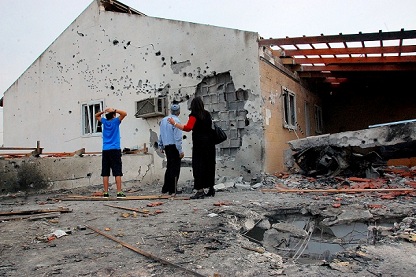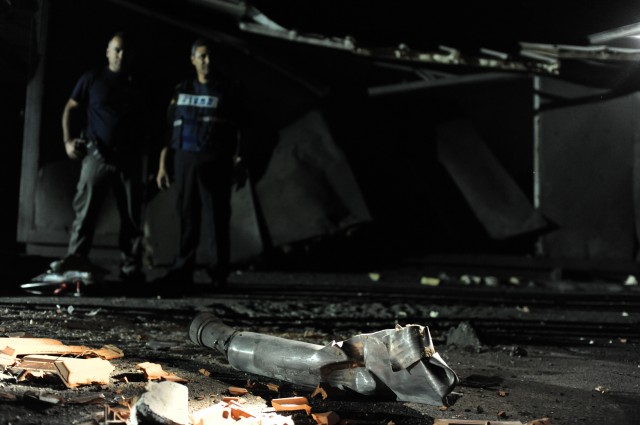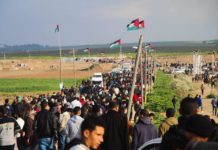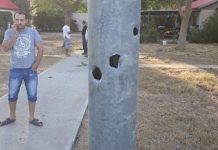This November 2013, southern Israel marks one year since the Gaza ‘Operation Pillar of Defense’.
This November, southern Israel marks one year since the IDF’s Operation Pillar of Defense in the Gaza Strip. It has been the quietest year in quite awhile, with “only” 79 rockets and missiles fired at southern Israeli communities. This is the fourth cease-fire between Israel and Hamas in the past seven years, the first having been on November 26, 2006.
Zohar family from Netivut, staring at their damaged home after it was hit by an Iranian Grad missile fired from Gaza, Tal Zohar, 11 years old in the photo was home alone at the time of the expolsoin, 18/11/12, Noam Bedein, Sderot Media Center.
Southern Israel has sustained hundreds of rocket attacks during these cease-fires. The last cease-fire lasted from the end of Operation Cast Lead on January 18, 2009, to the first day of Operation Pillar of Defense on November 12, 2012. During that period, approximately 2,000 rockets and missiles were fired from Hamas-controlled Gaza, sending one million Israelis running to shelters with between 15-45 seconds’ warning.
The most important lesson that we as Israelis need to learn is that after the last Gaza operation, within seven years of the disengagement in the Gaza strip in August 2005, most Israeli citizens came under Iranian missile fire from Hamas-controlled Gaza. Tel Aviv and Jerusalem were put into range of missile fire, and the most heavily bombarded city was Ashdod, the fifth most-populated city in Israel.
According to Israeli intelligence sources, there remain in Gaza thousands of long-range missiles hidden deep within Gaza’s civilian buildings and infrastructure. In ‘Operation Pillar of Defense,’ Iranian Fajar missiles were fired near the Shifa hospital in Gaza towards Jerusalem. Israel renovated the Shifa hospital in the 1980s.
The ‘Iron Dome’ battery defense system received a great deal of media attention during and after the Operation, implying that this was the military solution for the rocket fire from Gaza. While there is no doubt this has brought about a change in the strategic warfare combating Hamas, it has definitely not solved the problem of rocket fire-far from it.
During the Operation there were five operational batteries intercepting missiles in mid-air. As there are hundreds of mid-sized towns and cities in southern-central Israel within a 75-kilometer range of Gaza, it has been always a game of ‘Russian roulette’ as to what areas or cities the ‘Iron Dome’ could protect.
A damaged house in the Be’er Tuvia Regional Council following a direct hit by a rocket fired from Gaza. November 16, 2012.
The Iron Dome does not protect the western Negev communities and the section of Sderot that is up to 4.5 kilometers from the Gaza border, because the 15 seconds it takes to fire an advanced Qassam rocket until the explosion in these communities just does not leave enough time to intercept the rocket.
Thus, a ‘creative solution’ has been given for Sderot and the western Negev communities to turn into ‘the bomb shelter capital of the world’. 500 million shekels were invested only for Sderot to build 6,000 new bomb shelters, and up to 500 million US dollars to protect the western Negev communities in the 4.5 kilometer radius, including public buildings and schools.
As director for seven years of the Sderot Media Center, I can attest to the fact that Israel has not provided a solution to the rocket fire or threat, and that we should expect many more years of living through rocket and missile escalations, in addition to years of rehabilitation for an entire population that has entered its 14th year of living under rocket fire and threat.
The current ‘relative quiet’ in the western Negev has resulted a near-absence of attention to the Hamas-controlled Gaza element in the current peace talks.
The ‘Two-State Solution’ remains high on the agenda of the Israeli government, as well as the focus of the Israeli media. However, hardly any mention is made of the ‘Hamstan’ state established in Gaza, after the one-sided Israeli action giving ‘land for peace’ on August 2005, leaving Gaza empty of a Jewish presence, civilian or military.
The lack of governmental and media attention to the current conflict between southern Israel and Hamas-controlled Gaza (even if it is largely at this point a matter of low-intensity warfare) in no way affects the very possible outcome of any withdrawal by agreement, or even worse, ‘separation plan’ (of which Tzipi Livni is very proud), from territories in the mountain ranges of Judaea and Samaria looking over the center of Israel.
Ben Gurion airport, Israel’s only international airport, less than 3 kilometers from the western Judaean mountains. The Sderot case has taught us that the most advanced technology in the world cannot stop a qassam rocket followed by an explosion after 15 seconds. One may ask: how many Israelis will live on the borders of a demilitarized Palestinian state?
Hamas today is in control of the entire Gaza strip and its population of 1.7 million Palestinian Arabs. Hamas makes sure to remind Israel and the rest of the world that they won US and EU-supervised elections in all the Palestinian territories in January 2006. Since then, there have been no elections. Again, one may ask: who does Abu-Mazen actually represent? Who chose him?
In April, 2013, during US President Obama’s visit to Israel, on his second-day visit to Ramallah, Hamas fired five rockets towards southern Israel, two exploding into Sderot. One rocket exploded underneath a children’s bedroom of the Haziza family , and one rocket exploding directly into a children’s kindergarten. This took place during Passover vacation, so no injuries were sustained, but the attack barely received media attention.
One million Israelis in southern Israel living within missile range of Hamas-controlled Gaza are asking themselves: “If Hamas and the rocket fire and threat not part of the current negotiations and peace talks, how is it possible to reach an agreement? Could we reach the absurd situation in which ‘peace’ is achieved and the rockets continue to be fired?”
The more we ignore the conclusions and policy Implications of ‘Operation Pillar of Defense’ the more illusions we build…
Noam Bedein is a photojournalist, lecturer and founder/director of Sderot Media Center . He has conducted briefings and tours for government officials, diplomats, foreign press, and students from around the world. Recently he produced a short documentary for the US Embassy- ‘Standing Resilient in Israel’














